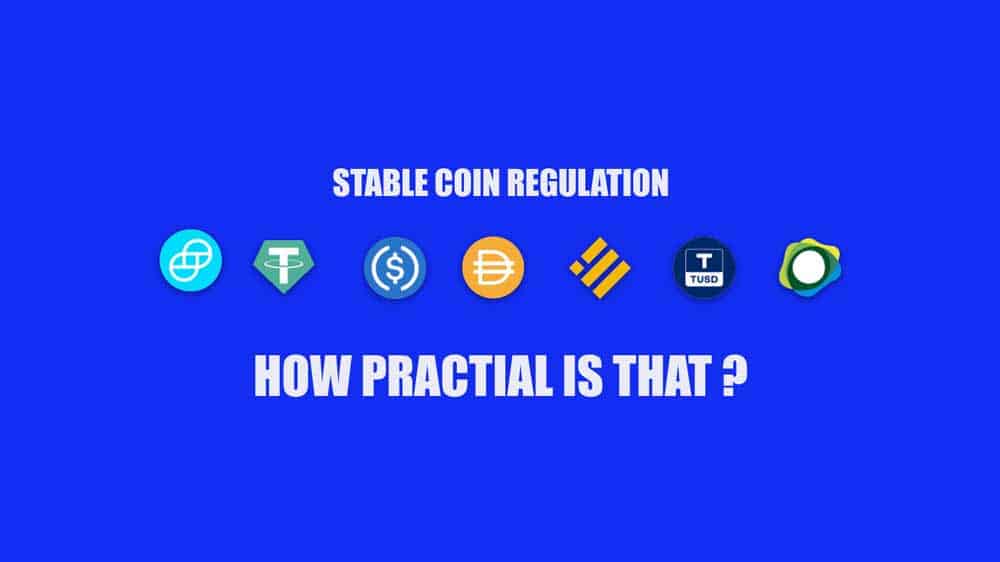Stablecoin Regulation: How will the Integration Of Stablecoin With Traditional Financial Institutions work practically?
In an announcement posted on social media platform Twitter, popular crypto exchange FTX is looking to partner with banks willing to accept stablecoins as a means of facilitating deposits and withdrawals from its exchange.

The announcement further stated that the exchange is open to reward the first banks in different regions willing to offer a $1 million cash prize. In conclusion, the announcement encouraged bank officials looking to reach out with the hope of striking a partnership on this proposal.This announcement by crypto exchange FTX follows past calls by other notable crypto platforms and investors to include stablecoins and other digital assets into the portfolio of traditional financial institutions.Although not yet in practice, there are many benefits to integrating stable coins into the traditional banking system. In this article, we will look at some of these benefits. However, before considering the benefits, let us take briefly discuss stable coins. Since many newbies to the crypto space may ask, “What is a Stablecoin?”. Additionally, we will consider the existing relationship between stable coins and traditional financial institutions.
What Are Stablecoins?
Stable coins are an outcome of decentralized finance (DeFi). Stable coins were developed in response to the cryptocurrencies’ constant volatility and price fluctuations. In order to maintain constant value, these digital assets are pegged to fiat currencies. As a result, stablecoin price have the same value as the fiat currencies to which they are tethered.As previously stated, these digital assets are not volatile. Similarly, they are not prone to fluctuations that often occur in the crypto markets. Consequently, they are a reliable way for traders and investors to hold digital assets without worrying about their value diminishing.
There are different types of stable coins available. Some examples of stable coins tethered to the value of the United States Dollar include Tether (USDT), Binance USD (BUSD), TerraUSD (UST), USDC, and DAI.
Stablecoin Regulation And Traditional Financial Institutions
Traditional financial institutions, such as banks were not included in the development of stablecoins. Instead, these digital assets were created to serve as non-bank solutions for crypto traders and investors.However, with an increase in the rate of adoption of cryptocurrencies, these digital assets can be used to greater effect when banks adopt them as a payment option for deposits and withdrawals. Moreover, stablecoins will not be effective if traditional banking is not involved. This point is critical because banks help to facilitate the transfer of fiat currencies in exchange for stablecoins and other cryptocurrencies within crypto traders and their crypto exchanges. Additionally, to verify the legitimacy of a stable coin, developers of that coin must deposit fiat currencies into FDIC-insured banks.Due to this requirement, most stable coins pegged to the United States Dollar (USD) have licenses showing cash reserves in various FDIC-insured banks. However, it is essential to note that the Federal Deposit Insurance Corp only insures some of the deposits made by developers of the stablecoin. Currently, the Federal Deposit Insurance Corporation only insures stablecoin deposits up to $250,000 per user. A significant reason for this problem is that big-name banking institutions like JPMorgan and Goldman Sachs are yet to serve as deposit reserves for stable coins.Instead, only a handful of small banks favourable to cryptocurrencies currently serves as FDIC-insured banks for stable coin cash reserves. Some of these banks include Signature Bank and Silvergate Bank. Signature Bank serves as an FDIC-insured bank for several stable coins, including TrueUSD (TUSD). Similarly, Silvergate bank serves as the FDIC insured bank Meta stable coin Diem (formerly Libra).Due to a lack of stable coin regulation and a lack of cooperation by most banks with cryptocurrency projects, many stable coins don’t hold cash reserves with FDIC insured banks. A famous example is the top stable coin, Tether (USDT).According to a recent report on stable coins provided by backers of the Tether project, the core team claims that it holds approximately 10% of its reserves in bank and cash deposits. Additionally, most of these cash deposits are held in a bank located in the Bahamas.The USD coin (USDC) is another stable coin without a cash reserve in an FDIC insured bank. Instead, the core developers of the project hold all of its cash reserves in what they call cash and cash equivalents. The cash and cash equivalents are basically a collection of bank deposits and highly liquid investments that can be accessed in less than or within a 90 day period.Despite the continued use of these stable coins by crypto users despite a lack of uniform stablecoin regulation, there is a need for regulatory authorities to develop and maintain uniform regulations that will guide the conduct of these assets. One way this can be achieved involves encouraging financial institutions like banks to integrate these digital assets into their platforms. Let us consider some of the benefits that will result from such an integration.
Benefits Of integrating Stablecoin Regulation with Traditional Financial Institutions
By incorporating stable coins into their platforms, banks can attain several benefits. One of the main benefits includes higher patronage from existing crypto traders. Banks that adopt stable coins will receive a higher level of patronage due to their ease when making deposits and withdrawing funds from their platforms.Another benefit will be a significant reduction in the transaction costs due to the low nature of transaction fees attached to crypto transactions.This benefit can be expected due to the low nature of transaction fees attached to crypto transactions.Finally, there would be a massive reduction in third parties’ use since cryptocurrencies are designed to remove external interference from financial transactions. It is important to note that all savings made due to the incorporation of stable coins by financial institutions will add to the profit margin of these organizations.Since cryptocurrencies are designed to remove external interference from financial transactions, the adoption of stable coins will significantly reduce the use of third parties or intermediaries from financial transactions. It is important to note that financial institutions’ savings made due to the incorporation of stable coins will be added to these organisations’ profit margins. These will indicate increased profits due to the incorporation of stable coins.Accepting stable coins will also indicate advanced financial inclusion for all types of customers on the part of banks and other financial institutions. It will also help in the regulation of stable coins since regulators will monitor their use in the banking industry.Finally, banks that accept stable coins will, in so doing, provide a platform for the incorporation of innovative ideas that are already positively revolutionizing the online payment industry.
Important links on Stablecoin Regulation:
https://home.treasury.gov/system/files/136/StableCoinReport_Nov1_508.pdf
https://www.cftc.gov/PressRoom/PressReleases/8450-21
https://www.consumerfinance.gov/about-us/newsroom/statement-cfpb-director-chopra-stablecoin-report/
https://home.treasury.gov/news/press-releases/jy0454
https://www.banking.senate.gov/imo/media/doc/Goldstein%20Testimony%2012-14-21.pdf
Finally on stablecoin regulation
While not yet in practice, many indications point to the adoption of stable coins by household banks and financial institutions in the United States. For instance, financial institutions such as Bank of America and Goldman Sachs are currently hiring blockchain and digital assets experts. Similarly, some banks are looking to create their own stable coins.These factors indicate that shortly we may begin to see various financial institutions adopt stable coins for deposits and withdrawals. When such a move does occur, we can expect to see some form of partnerships formed between current backers of stablecoins, crypto exchanges, and these traditional financial institutions.









